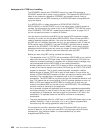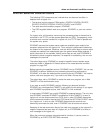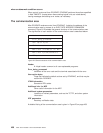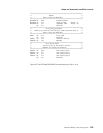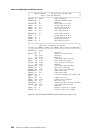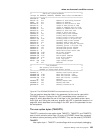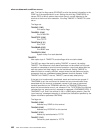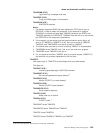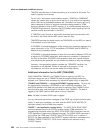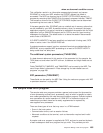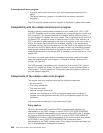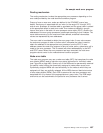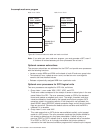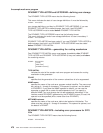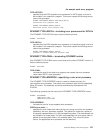TWAOOS indicates that no further processing is to be done for this node. The
node is logically out of service.
For an LU6.1 intersystem communication session, TWAOOS or TWAONINT
causes the system entry to be put out of service if, as a result of the specified
action, there are no allocatable sessions left. (A session can also be put out of
service because of either an unknown modename being passed to VTAM
during an attempt to bind an APPC session, or an invalid logmode name for a
VTAM 3270-type terminal. However, the CICS default action resulting from this
condition cannot be overridden in the NEP.)
If TWAOCN is set, the task is abnormally terminated and communication with
the node is lost. Note that the NEP cannot reset this flag.
TWAOSCN provides the same function as TWAONCN, but the NEP can reset it
if the session is not to be closed.
If DFHZNAC is scheduled because of the receipt of an exception response, the
sense information in the TCTTE is available to DFHZNAC and DFHZNEP to
determine any necessary actions.
If DFHZNAC is scheduled because of loss of the connection between CICS and
a logical unit, DFHZNAC abnormally terminates any transaction in progress at
the time of the failure. DFHZNEP and transaction-class error routine analysis
and processing are permitted, but you should not attempt to retry the message.
However, if the application program handles the ‘TERMERR’ condition, the
transaction is not abended. Control is returned to the program. In this
circumstance, no further use can be made of the failed session.
Additional information for the NEP (TWAADINF)
Fields TWANPFW, TWANLD, and TWANLDL can be reset by the NEP. For
information about the use of TWANPFW, see the supplied sample node error
program, and “Optional error processor for interactive logical units” on page 469.
TWANLD and TWANLDL — using the DFHZNAC logging facility:
You can use
the logging facility available in DFHZNAC to aid in retrieving information. You
specify the address of the data that you want to examine in field TWANLD of the
communication area, and the length of the data in field TWANLDL. The data is
logged to the CSNE transient data queue for future inspection.
Note: No data in excess of 220 bytes is logged.
You can also send user-written messages to the CSNE log using the transient data
facility. To write your messages, you must code the EXEC CICS WRITEQ TD
instruction directly into the node error program.
TWAPIP — and application routing failure:
The EXEC CICS ISSUE PASS
command passes control from CICS to another named VTAM application. For
programming information about the EXEC CICS ISSUE PASS command, see the
CICS Application Programming Reference
manual. The ISSUE PASS command in
turn invokes the VTAM macro CLSDST with OPTCD=PASS, and, in addition, if
NOTIFY has been specified on the CLSDSTP system initialization parameter, with
PARMS=(THRDPTY=NOTIFY). CICS is then notified of the outcome of any
CLSDST request.
when an abnormal condition occurs
464
CICS TS for OS/390: CICS Customization Guide



